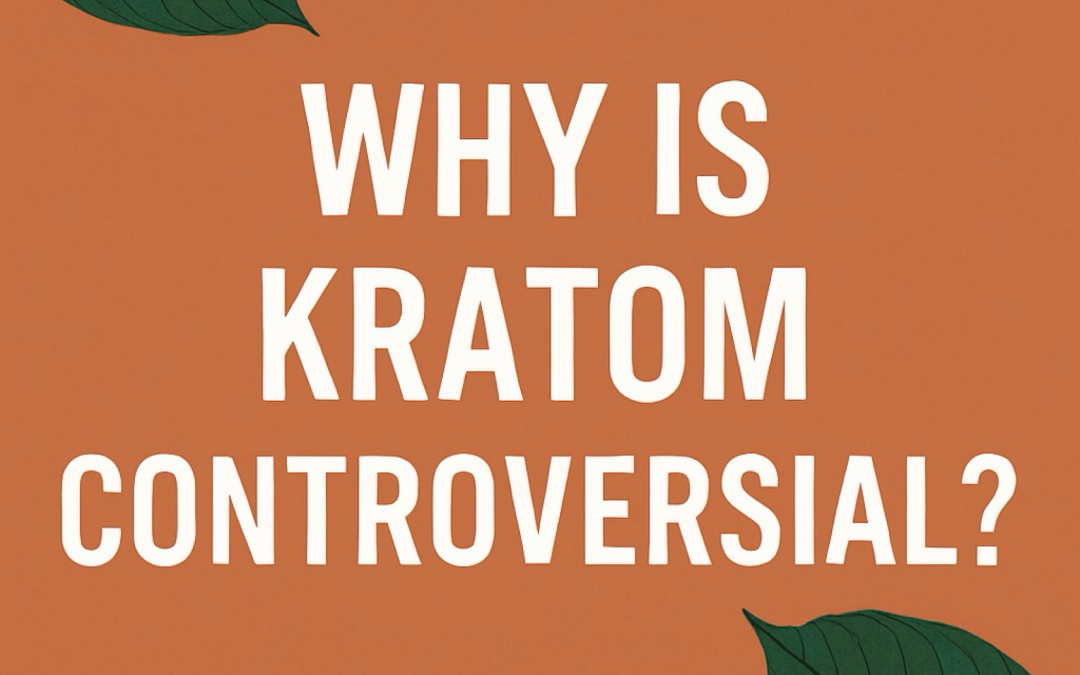
by KratomUSA | Sep 29, 2025 | Kratom
🌿 A Balanced Look at Benefits, Safety, and Misunderstandings
Kratom (Mitragyna speciosa) is a tropical tree native to Southeast Asia, where its leaves have been used for centuries to support energy, relieve discomfort, and promote relaxation. In recent years, kratom has gained popularity in the United States as a natural wellness alternative. But with this rise in interest has also come controversy. Some people praise kratom as a safe and effective botanical, while others raise concerns about its potential misuse.
So why is kratom controversial — and what does the evidence really say? Let’s explore the history, benefits, and scientific facts behind this natural plant.
🔑 Key Points
-
Kratom has been used safely for centuries in Southeast Asia.
-
It is not an opiate, though it interacts with some of the same receptors.
-
Kratom does not suppress breathing the way opioids do.
-
Benefits include energy, relaxation, mood support, and pain relief.
-
Controversy stems from misinformation, misuse, and regulatory uncertainty.
📜 A Long History of Safe Use
For hundreds of years, kratom leaves have been chewed or brewed as tea by farmers and laborers in Thailand, Malaysia, and Indonesia. Traditionally, small doses were taken to fight fatigue and increase endurance during long hours of work. Larger doses were used for relaxation in the evenings or to ease aches and soreness. This cultural history shows kratom as a plant-based aid used in daily life, not as a substance of abuse.
🌱 Benefits of Kratom
Modern kratom users often report a wide variety of benefits:
-
Energy & Focus: In small amounts, kratom can provide a clean boost of energy without jitters.
-
Mood Support: Many find kratom helps with relaxation, positivity, and emotional balance.
-
Pain Relief: At higher doses, kratom may soothe discomfort and support better rest.
-
Muscle Relaxation: Red vein kratom in particular is valued for calming sore or tense muscles.
While research is still ongoing, surveys and studies show that kratom is widely used as a safer alternative to opioids or as a natural wellness option.
🚫 Why Kratom Is Not an Opiate
One of the biggest misunderstandings about kratom is that it is often called an “opiate.” This is not true.
-
Opiates are substances directly derived from the opium poppy, like morphine or heroin.
-
Kratom, however, is a plant in the coffee family. Its primary alkaloids, mitragynine and 7-hydroxymitragynine, do interact with opioid receptors — but in a very different way.
Unlike opiates, kratom does not cause the same level of respiratory depression (slowed or stopped breathing), which is the most dangerous side effect of opioid overdose. This is one of the key differences that makes kratom much safer.
😮💨 Kratom and Breathing Safety
A major reason for kratom’s controversy is fear that it carries the same risks as opioids. However, scientific studies have shown that kratom does not suppress the respiratory system like opioids do. In fact, research in animals and human reports confirm that kratom’s alkaloids lack the powerful respiratory depression effect of drugs such as oxycodone, fentanyl, or heroin.
This difference is critical: while opioids can be fatal in high doses due to slowed breathing, kratom’s natural alkaloids do not have the same dangerous impact.
⚖️ Why Is Kratom Controversial?
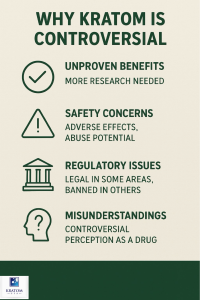 If kratom has so many benefits and a strong safety record, why is it controversial? A few reasons stand out:
If kratom has so many benefits and a strong safety record, why is it controversial? A few reasons stand out:
-
Regulatory Uncertainty: Some U.S. states restrict kratom, while others protect it through the Kratom Consumer Protection Act (KCPA). Federal regulation is still unclear.
-
Misuse & Misinformation: A small number of cases involving adulterated or combined products (kratom mixed with other substances) have led to alarmist headlines. Pure kratom, however, has not been shown to cause fatal overdoses.
-
Confusion with Opiates: Because kratom interacts with opioid receptors, it is often incorrectly lumped in with dangerous opioids, despite critical differences in chemistry and effects.
🗣️ What Real Users Say
“Kratom gave me my life back. I use it for chronic back pain, and it lets me function without prescription opioids.” — Sarah K.
“As a coffee alternative, green vein kratom keeps me alert and focused during work without the jitters.” — Jason M.
“Red Bali helps me relax at night and manage soreness from the gym. I sleep better and wake up refreshed.” — Lindsay R.
❓ FAQ
Q: Is kratom an opioid?
A: No. Kratom is part of the coffee family, not the opium poppy family.
Q: Can kratom stop your breathing?
A: No. Unlike opioids, kratom does not suppress breathing in normal use.
Q: Why is kratom banned in some states?
A: Mostly due to misinformation, lack of education, and regulatory caution.
Q: What is the Kratom Consumer Protection Act?
A: A law in some states that ensures kratom is sold safely and responsibly.
Q: Is kratom addictive?
A: Like coffee, regular use can lead to dependence for some, but it is not comparable to opioid addiction.
🌿 Final Thoughts
Kratom is controversial because it is misunderstood. While some confuse it with opioids, the truth is that kratom is a natural plant in the coffee family with a long record of safe, traditional use. It offers unique benefits for energy, mood, and relief — and unlike opioids, it does not suppress breathing.
As more research emerges and regulations improve, kratom is becoming recognized not as a dangerous substance, but as a valuable botanical that deserves a fair and balanced place in the wellness world.
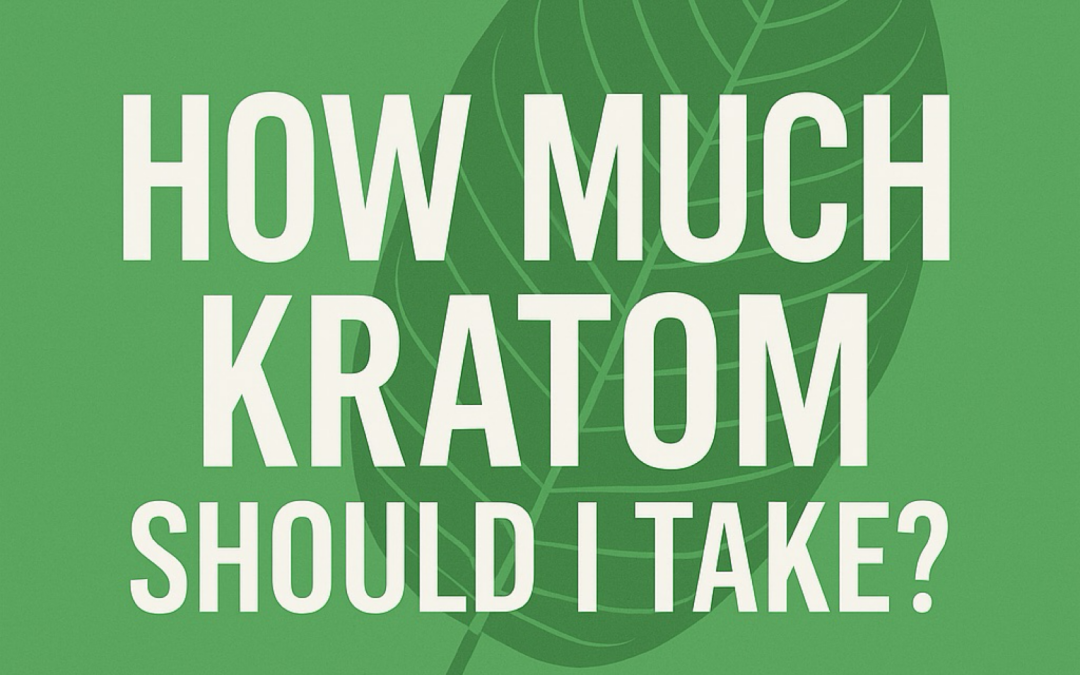
by KratomUSA | Sep 26, 2025 | Kratom
🌿 A Guide to Finding the Right Kratom Dosage for You
Kratom (Mitragyna speciosa) has become increasingly popular as a natural supplement for energy, mood support, focus, and relief from discomfort. But if you’re new to kratom, one of the first questions you’ll have is: How much kratom should I take?
The truth is, there isn’t a single “one-size-fits-all” answer. The right kratom dosage depends on several factors, including your body weight, tolerance, strain, and the effects you’re hoping to achieve. Taking too little may leave you disappointed, while taking too much can lead to side effects like nausea or drowsiness. This article will break down everything you need to know about finding the right kratom dosage safely and effectively.
🔑 Key Points
-
Low doses (1–3 grams) tend to produce energizing, stimulating effects.
-
Moderate doses (3–5 grams) may provide a balance of energy and relief.
-
Higher doses (5–8 grams) are typically more sedating and are used for pain or relaxation.
-
Dosage depends on factors like body weight, tolerance, strain type, and method of consumption.
-
It’s best to start small and gradually adjust until you find your “sweet spot.”
Factors That Affect Kratom Dosage
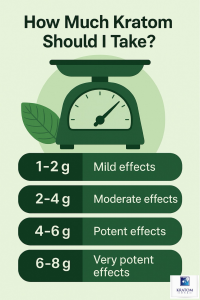 1. Body Weight & Sensitivity
1. Body Weight & Sensitivity
Like many natural supplements, heavier individuals may require slightly higher doses to feel the same effects. But sensitivity matters too — some people feel strong results at just 2 grams.
2. Strain Type
-
White vein kratom is usually energizing, and lower doses (1–3 grams) are effective.
-
Green vein kratom offers a balance of stimulation and relaxation, often effective in the 2–5 gram range.
-
Red vein kratom is typically more sedating and often used at slightly higher doses (4–7 grams) for pain and sleep support.
3. Desired Effects
-
Energy and focus: 1–3 grams (low dose)
-
Mood support and moderate relief: 3–5 grams (medium dose)
-
Relaxation and pain relief: 5–8 grams (higher dose)
4. Form of Kratom
-
Powder may hit faster but requires careful measuring.
-
Capsules are convenient but often contain smaller amounts per pill (usually 0.5–1 gram each).
-
Extracts and tinctures are more concentrated and require much lower doses.
General Dosage Guidelines
Most users find their “sweet spot” in the 2–5 gram range. It’s best to wait 30–45 minutes after taking your dose to see how it affects you before considering more.
Safety Tips
-
Always start with the lowest effective dose.
-
Avoid mixing kratom with alcohol or other substances.
-
Take kratom on an empty stomach for stronger, quicker effects.
-
Rotate strains to avoid tolerance buildup.
-
Give your body breaks — daily heavy use can reduce effectiveness over time.
🗣️ Testimonials
“When I first tried kratom, I started with 1.5 grams of Green Maeng Da. That small amount gave me focus and calm energy that lasted all morning.” — Alex W.
“I use about 4 grams of Red Bali at night. It helps with my back pain and lets me finally sleep through the night.” — Janice L.
“At first I thought more would be better, but I learned quickly that too high a dose just made me groggy. My sweet spot is 3 grams.” — Marcus P.
❓ FAQ
Q: Can I take kratom every day?
A: Many people use kratom daily, but it’s smart to keep doses moderate and take breaks to avoid tolerance.
Q: How long do kratom effects last?
A: Typically 4–6 hours, depending on strain, dose, and your metabolism.
Q: What if I don’t feel anything at a low dose?
A: Wait at least 45 minutes before increasing slightly. Dosage adjustment should always be gradual.
Q: Is more always better?
A: Not at all — higher doses often produce sedating effects and may cause nausea. For most, the best results come from finding the lowest effective dose.
🌿 Final Thoughts
Finding the right kratom dosage is about balance. Too little may not give you the relief or energy you’re looking for, and too much may cause side effects. The safest and most effective way to find your “sweet spot” is to start low, go slow, and listen to your body. With patience and mindful use, kratom can be a powerful tool for well-being.
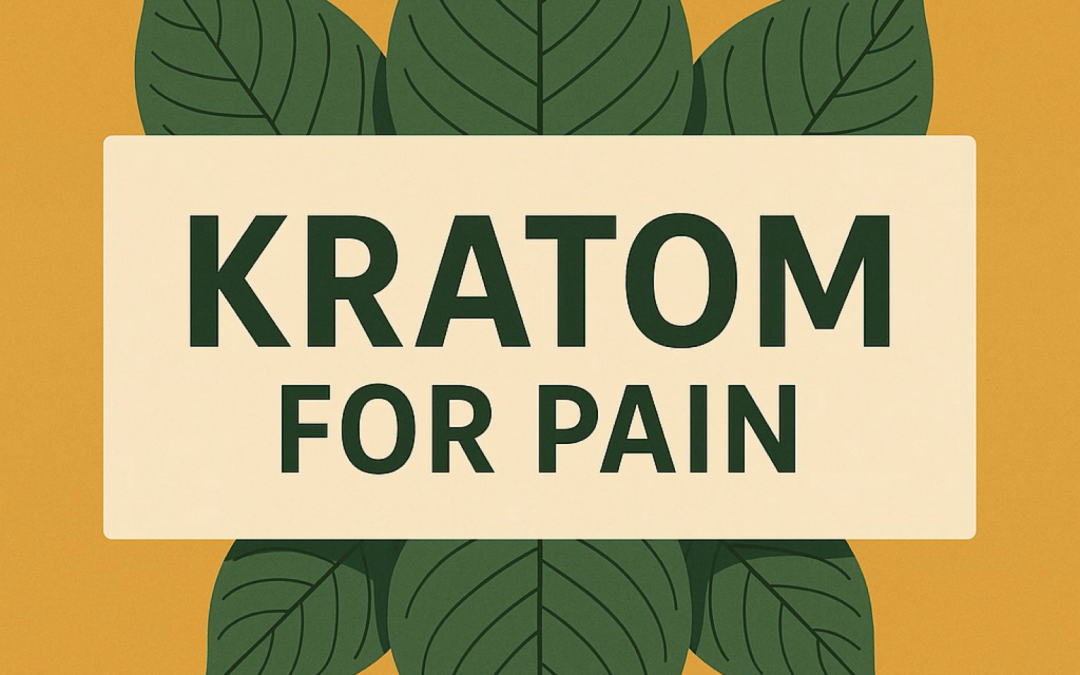
by KratomUSA | Sep 25, 2025 | Kratom
A Guide to the Types of Pain Kratom Relieves Best
Kratom (Mitragyna speciosa), a tropical evergreen from Southeast Asia, has been used for centuries as a natural remedy for discomfort and fatigue. In the West, it has become popular as an alternative option for pain relief. But here’s the big question: what types of pain does kratom work best for?
Unlike prescription opioids or over-the-counter painkillers, kratom does not numb pain indiscriminately. Instead, certain strains and alkaloids appear to work better for specific types of pain — especially muscle and body aches, joint pain, and chronic back pain. However, kratom may not be as effective for every type of pain, such as migraines or severe nerve pain.
🔑 Key Points
-
Kratom works best for musculoskeletal pain — backaches, joint stiffness, arthritis, and muscle soreness.
-
It is less effective for headaches or migraines, where blood vessel and neurological factors play a bigger role.
-
Different strains provide different effects: red vein strains for strong pain relief, green for balanced relief with energy, white for lighter discomfort.
-
Scientific studies suggest kratom’s alkaloids (mitragynine, 7-hydroxymitragynine) interact with opioid receptors to dull physical pain.
How Kratom Works for Pain Relief
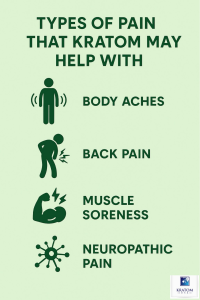 Kratom leaves contain over 40 alkaloids, but the two most studied are mitragynine and 7-hydroxymitragynine. These compounds bind to mu-opioid receptors in the brain — the same receptors targeted by prescription painkillers. Unlike opioids, however, kratom’s alkaloids also interact with adrenergic and serotonergic receptors, meaning it provides analgesia while also boosting energy and mood.
Kratom leaves contain over 40 alkaloids, but the two most studied are mitragynine and 7-hydroxymitragynine. These compounds bind to mu-opioid receptors in the brain — the same receptors targeted by prescription painkillers. Unlike opioids, however, kratom’s alkaloids also interact with adrenergic and serotonergic receptors, meaning it provides analgesia while also boosting energy and mood.
This makes kratom especially suited for body pain that lingers through the day, since it not only reduces discomfort but can also improve motivation and stamina.
✅ Pain Types Kratom Is Most Effective For
1. Back Pain and Spinal Discomfort
Chronic back pain is one of the top reasons people turn to kratom. Red vein strains (such as Red Bali or Red Maeng Da) are particularly popular, as they provide a relaxing body feel that eases spinal tension and reduces stiffness.
2. Muscle Aches and Soreness
Whether from exercise, physical labor, or chronic conditions like fibromyalgia, kratom helps relax tight muscles. Users often report that green vein kratom balances pain relief with enough energy to stay active.
3. Joint Pain and Arthritis
Kratom’s anti-inflammatory properties make it useful for arthritis and joint stiffness. Red strains are typically favored at night to reduce pain and promote sleep, while green strains can be taken during the day for mobility.
4. Nerve Pain (with Limitations)
Some users find relief for mild neuropathic pain, though kratom is generally less reliable for nerve-based pain compared to body aches. In these cases, results vary more from person to person.
🚫 Pain Types Kratom May Not Help As Much
-
Headaches and Migraines: Kratom is generally not very effective here. Migraines involve neurological, vascular, and hormonal factors that kratom doesn’t directly address. In some cases, it could even worsen headaches due to dehydration.
-
Sharp, Acute Pain (like injuries or post-surgery): Kratom may dull the pain somewhat but is not a replacement for medical care in emergencies.
-
Localized Inflammation (like tooth pain): Relief may be partial, but kratom isn’t as targeted as dental or medical treatment.
What Science Says
-
A 2017 study in Drug and Alcohol Dependence found that kratom users frequently cited chronic pain relief as their main reason for use.
-
A 2020 review in Frontiers in Pharmacology highlighted kratom’s potential as an analgesic, particularly for musculoskeletal discomfort, but also noted the lack of large-scale clinical trials.
-
User surveys (American Kratom Association, Johns Hopkins Medicine) show back pain, arthritis, and fibromyalgia as the most commonly reported conditions where kratom provides significant relief.
🌿 Testimonials from Real Users
“I’ve struggled with lower back pain for years. Red Bali kratom has been the only thing that gets me through the workday without feeling sedated.” — Michael T.
“For arthritis in my knees, kratom has been a lifesaver. I use Green Maeng Da in the mornings to stay active and Red Borneo at night to actually sleep without pain.” — Janice R.
“I tried kratom for migraines, but it didn’t help much. However, for muscle soreness after workouts, it’s incredible.” — Derek L.
📝 Summary
Kratom is best suited for:
-
Chronic back pain
-
Muscle aches and soreness
-
Joint stiffness/arthritis
-
Some cases of mild nerve pain
It is less effective for:
-
Migraines/headaches
-
Acute injuries
-
Highly localized pain
❓ FAQ
Q: What strains of kratom are best for pain?
A: Red vein kratom (Red Bali, Red Maeng Da) is strongest for pain relief. Green vein strains (Green Malay, Green Maeng Da) balance pain relief with energy. White strains are less effective for pain, better for mood and focus.
Q: Can kratom replace prescription painkillers?
A: Not entirely. Kratom can help manage chronic pain, but it should not be used as a sole substitute for serious medical conditions without consulting a doctor.
Q: Does kratom work right away?
A: Effects usually begin within 30–45 minutes and last 4–6 hours, depending on strain and dose.
Q: Is kratom safe for daily pain relief?
A: Many users take kratom daily, but tolerance can build. Experts recommend using moderate doses, rotating strains, and taking breaks when possible.
✨ Final Thought:
Kratom isn’t a one-size-fits-all painkiller. But for body aches, chronic back pain, muscle soreness, and arthritis, it can provide natural relief where other options fall short — all while supporting energy and mood.
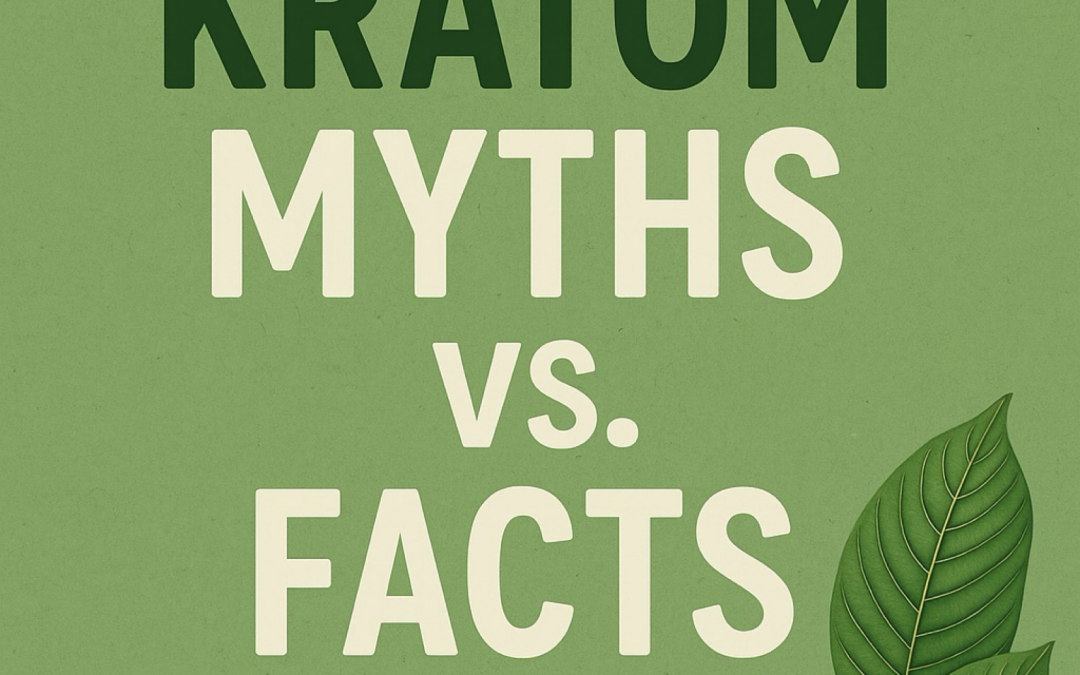
by KratomUSA | Sep 21, 2025 | Kratom
⚖️ Separating Truth from Fiction in the World of Natural Kratom
Kratom has been used for centuries in Southeast Asia, but as it gains popularity in the West, it’s also attracted its fair share of misinformation. From labeling it as a “synthetic drug” to calling it an “opioid,” the internet is full of myths that confuse potential users and misrepresent what this natural plant really is. In this article, we break down the most common kratom myths vs. facts, so you can make informed decisions.
✅ Key Points
-
Kratom is a natural botanical from Southeast Asia, not a synthetic substance.
-
It is not classified as an opioid, although it interacts with some of the same receptors.
-
Many reports of dangers stem from adulterated or synthetic products, not natural kratom.
-
Studies and centuries of use support the safety of full-spectrum, all-natural kratom.
-
Kratom USA provides pure, lab-tested kratom with nearly 20 years of trusted service.
🌿 Myth #1: Kratom Is a Synthetic Drug
🟢 Fact: Kratom is 100% natural.
Kratom (Mitragyna speciosa) is a tropical tree native to countries like Thailand and Indonesia. The leaves are harvested, dried, and ground into powder or brewed as tea—no chemical processing needed.
🔬 Researchers in Phytomedicine confirm that kratom contains natural alkaloids like mitragynine and 7-hydroxymitragynine, both found directly in the leaf itself.
💊 Myth #2: Kratom Is an Opioid
🟢 Fact: Kratom is not pharmacologically classified as an opioid.
While kratom interacts with opioid receptors, it behaves very differently from traditional opioids. Kratom doesn’t cause the same respiratory depression—one of the deadliest risks associated with opioid overdose.
🧪 In fact, a 2024 review in Frontiers in Pharmacology explains how kratom’s alkaloids act as “partial agonists” at mu-opioid receptors, which reduces the risk of severe side effects.
🚨 Myth #3: Kratom Is Dangerous and Unregulated
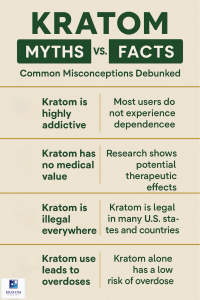 🟢 Fact: Natural kratom is safe when sourced from a trustworthy vendor.
🟢 Fact: Natural kratom is safe when sourced from a trustworthy vendor.
Problems often arise when people consume adulterated or synthetic kratom extracts with high concentrations of 7-hydroxymitragynine. Natural kratom, when taken responsibly, has a long history of safe use.
🎯 Tip: Always buy from companies like Kratom USA, which provide lab-tested, pure, and natural kratom without additives.
🛑 Myth #4: Kratom Is Addictive
🟢 Fact: Kratom has a low potential for dependence when used responsibly.
Just like coffee (which also contains alkaloids), kratom can lead to mild physical dependence in some users. However, most users report being able to take breaks without serious withdrawal.
📣 Testimonial:
“I use kratom 4–5 days a week for my lower back pain. On days I don’t take it, I feel fine. It’s nothing like the painkillers I used to rely on.”
— Tamika R., Austin, TX
⚖️ Myth #5: Kratom Is Only Used Recreationally
🟢 Fact: Most users take kratom for wellness reasons.
Surveys show that people use kratom for:
A 2020 Johns Hopkins study found over 90% of kratom users reported using it for health-related benefits.
🧬 Myth #6: All Kratom Is the Same
🟢 Fact: There’s a big difference between natural full-spectrum kratom and synthetic isolates.
Synthetic kratom extracts can be dangerously potent. Full-spectrum kratom preserves the natural balance of alkaloids, providing a gentler, more predictable experience.
💚 That’s why Kratom USA proudly sells only natural kratom—tested, pure, and trusted since the early 2000s.
🧾 Key Points Recap
-
Kratom is a natural plant, not synthetic or artificial.
-
It is not classified as an opioid, though it interacts with opioid receptors.
-
Problems arise with synthetic or adulterated kratom, not pure leaf.
-
Kratom has a long record of traditional use in Southeast Asia.
-
Choose full-spectrum, all-natural kratom from trusted vendors like Kratom USA.
❓ FAQ: Kratom Myths vs. Facts
Is kratom legal in the U.S.?
Kratom is legal in most states, but some local bans exist. Check your local laws.
Can kratom cause an overdose?
Natural kratom alone has a very low risk of overdose. However, synthetic kratom products or mixing kratom with other drugs can be dangerous.
Does kratom affect the brain like opioids?
It interacts with the same receptors but is less likely to cause sedation, addiction, or overdose.
Is there research supporting kratom’s safety?
Yes! Studies from Johns Hopkins, NIDA, and others show that most users report positive health benefits and low risk of harm.
🧠 Conclusion: Know the Facts, Dismiss the Fiction
Kratom’s misunderstood reputation stems from misinformation and the abuse of synthetic forms. Natural kratom, especially when sourced from experienced vendors like Kratom USA, has been used safely for generations.
✔️ Educate yourself.
✔️ Choose full-spectrum, natural kratom.
✔️ Debunk the myths—and enjoy the benefits responsibly.
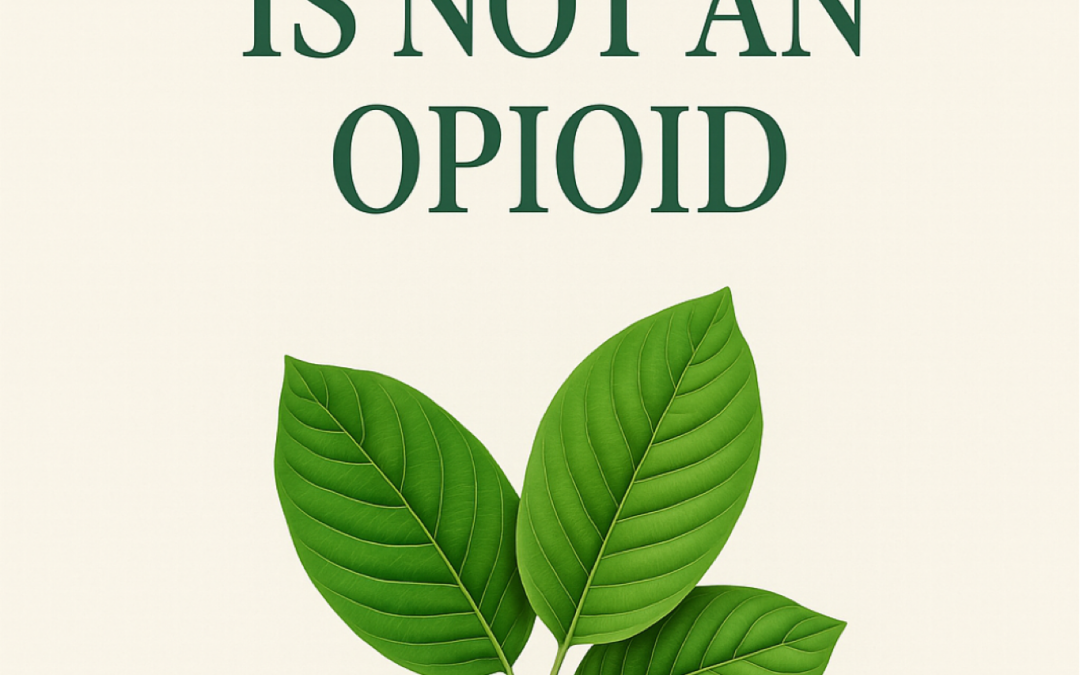
by KratomUSA | Sep 19, 2025 | Kratom
🌿 Understanding Kratom’s Unique Properties and Why It Deserves a Category of Its Own
Kratom has sparked debate in the wellness world and beyond, with many wondering: “Is kratom an opioid?” The confusion often arises because kratom interacts with opioid receptors in the brain—yet it doesn’t behave like traditional opioids such as morphine or oxycodone. In this article, we’ll explore why kratom is not an opioid, what makes kratom different, the science behind its effects, and why full-spectrum, all-natural kratom deserves recognition as a safe botanical with a long-standing history of use.
🔍 Key Points
-
Kratom is a natural plant, not derived from opium.
-
It interacts with opioid receptors but doesn’t act like synthetic opioids.
-
Natural kratom contains a balance of over 40 alkaloids.
-
It has been used safely in Southeast Asia for hundreds of years.
-
Full-spectrum kratom is preferable to synthetic isolates.
🌿 What Is Kratom, Really?
Kratom (Mitragyna speciosa) is a tropical tree native to Southeast Asia. For centuries, locals have chewed its leaves or brewed them into tea for energy, pain relief, and relaxation. Unlike opioids, kratom is not extracted from the poppy plant and doesn’t belong to the opioid class chemically. Yet, its primary alkaloids—mitragynine and 7-hydroxymitragynine—do bind to the same mu-opioid receptors.
The result? Kratom can provide pain relief and mild euphoria without the intense respiratory depression or high overdose risk of synthetic opioids.
🧬 How Kratom Works in the Body
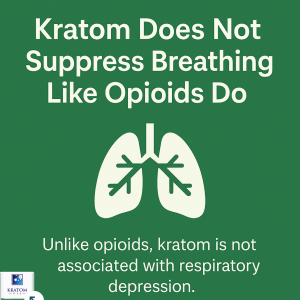 While opioids fully activate the brain’s opioid receptors, kratom’s alkaloids are partial agonists, meaning they stimulate the receptors to a much lesser degree. This provides some of the beneficial effects of opioids—like discomfort relief or calmness—without the same level of risk or dependency.
While opioids fully activate the brain’s opioid receptors, kratom’s alkaloids are partial agonists, meaning they stimulate the receptors to a much lesser degree. This provides some of the beneficial effects of opioids—like discomfort relief or calmness—without the same level of risk or dependency.
Kratom also affects other systems in the body:
-
Adrenergic receptors – for energy and focus
-
Serotonin receptors – for mood regulation
-
Dopamine receptors – for motivation and pleasure
This multi-system effect makes kratom much more complex than a single-action opioid.
⚠️ Why Kratom Is Not an Opioid
| Feature |
Kratom |
Opioids (e.g. Morphine) |
| Plant Source |
Mitragyna speciosa |
Poppy plant |
| Receptor Binding |
Partial agonist |
Full agonist |
| Risk of Respiratory Depression |
Very low (natural kratom) |
High |
| Potential for Overdose |
Extremely rare (natural) |
High |
| Legal Status |
Legal in many U.S. states |
Prescription-only |
Although kratom shares a few receptor pathways, it does not produce the same dependency cycle or physiological suppression seen with narcotic opioids. In fact, many users report using kratom as a way to taper off or avoid traditional opioids altogether.
📚 What the Research Says
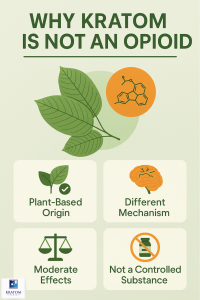 Several studies support the unique classification of kratom:
Several studies support the unique classification of kratom:
🛡️ Why Full-Spectrum Natural Kratom Is Best
Natural kratom contains over 40 bioactive alkaloids, all working together in a balanced, synergistic way. Synthetic products that isolate one compound—like 7-hydroxymitragynine—can amplify potency and risk.
With full-spectrum kratom, you get:
-
Balanced effects (energy, relief, calm)
-
Reduced risk of side effects
-
Effects that align with centuries of traditional use
🧠 Think of it like this: Would you rather drink orange juice or inject pure vitamin C? The body prefers the complexity of nature.
🛒 Trusting Your Vendor Matters
When buying kratom, choose a trusted source. KratomUSA.com has been a leader in all-natural kratom for nearly 20 years. Their products are:
-
Lab-tested for purity and potency
-
Full-spectrum—no synthetic isolates
-
Sourced from mature, organic trees
-
Shipped the same day when ordered by 2 p.m. EST
You deserve clean, safe, naturally balanced kratom—not a lab-made mimic.
🗣️ What Real Users Say
“Kratom helped me stop using prescription opioids after surgery. I’ve been using it safely for 3 years with no issues.” – David, NY
“I prefer natural kratom because it gives me a gentle lift without any crash or fog.” – Sarah, FL
📌 Final Thoughts
While kratom does interact with opioid receptors, it is not an opioid in the traditional or legal sense. Natural kratom is far less dangerous than synthetic opioids and has been used safely for hundreds of years. When used responsibly—and sourced from a vendor like Kratom USA—kratom can be a valuable tool in wellness and recovery.
❓ FAQ: Is Kratom an Opioid?
Q: Is kratom chemically an opioid?
A: No. Kratom contains alkaloids that bind to opioid receptors, but it’s not derived from opium and has a different structure.
Q: Can kratom cause an overdose?
A: Overdose risk is extremely low with full-spectrum kratom. The risk increases when synthetic extracts or other substances are involved.
Q: Is kratom addictive?
A: Kratom can be habit-forming with excessive use, but the withdrawal symptoms are generally mild compared to opioids.
Q: Why is full-spectrum kratom better than extracts?
A: Full-spectrum kratom offers balanced, natural effects. Isolates like 7-OH may have exaggerated potency and side effects.

 If kratom has so many benefits and a strong safety record, why is it controversial? A few reasons stand out:
If kratom has so many benefits and a strong safety record, why is it controversial? A few reasons stand out:


 1. Body Weight & Sensitivity
1. Body Weight & Sensitivity
 Kratom leaves contain over 40 alkaloids, but the two most studied are mitragynine and
Kratom leaves contain over 40 alkaloids, but the two most studied are mitragynine and 
 🟢 Fact: Natural kratom is safe when sourced from a trustworthy vendor.
🟢 Fact: Natural kratom is safe when sourced from a trustworthy vendor.
 While opioids fully activate the brain’s opioid receptors, kratom’s alkaloids are partial agonists, meaning they stimulate the receptors to a much lesser degree. This provides some of the beneficial effects of opioids—like discomfort relief or calmness—without the same level of risk or dependency.
While opioids fully activate the brain’s opioid receptors, kratom’s alkaloids are partial agonists, meaning they stimulate the receptors to a much lesser degree. This provides some of the beneficial effects of opioids—like discomfort relief or calmness—without the same level of risk or dependency. Several studies support the unique classification of kratom:
Several studies support the unique classification of kratom: